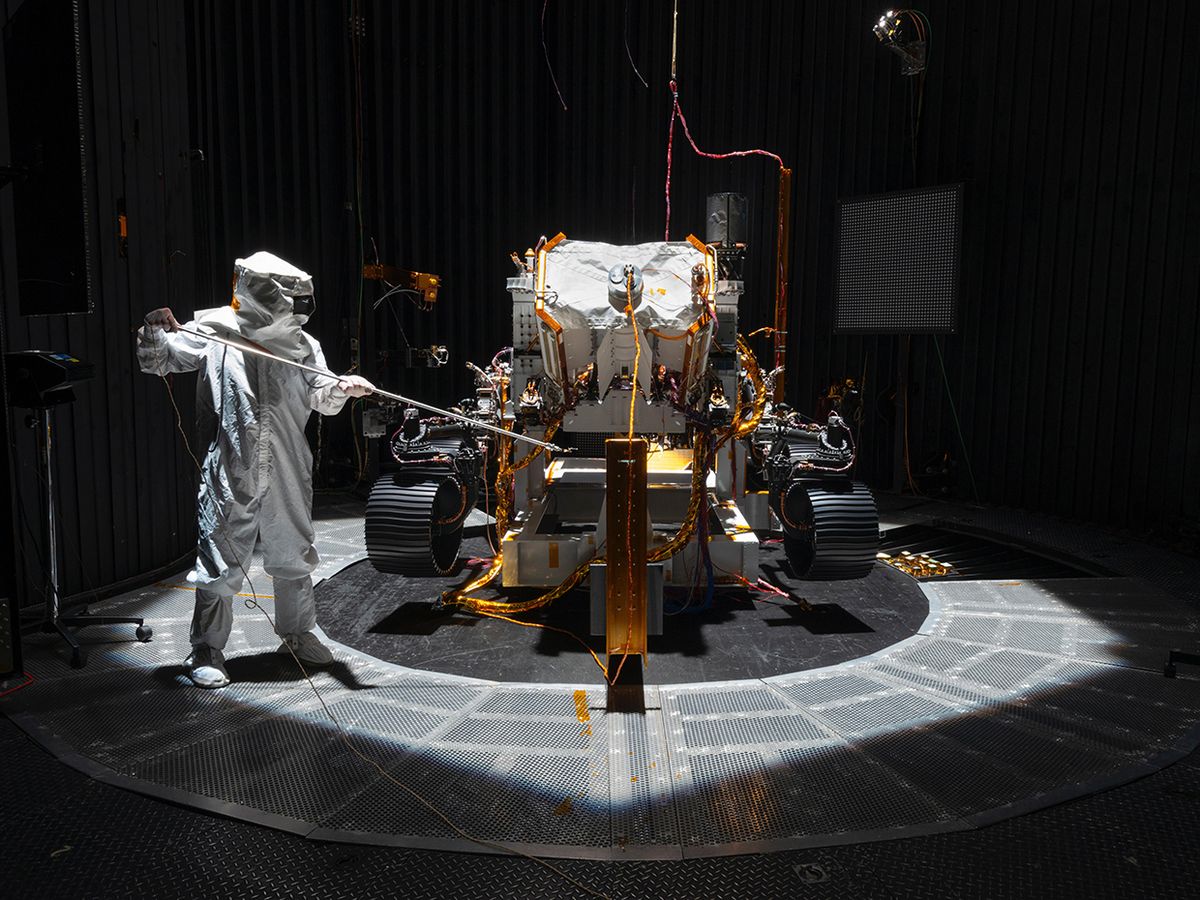4 Missions Will Search the Martian Atmosphere and Soil for Signs of Life
ExoMars 2020, Mars 2020, HX-1, and Hope will look for biology’s signature

A technician prepares to put NASA's Mars 2020 rover through its paces in a vacuum test chamber.
In 2020, Earth and Mars will align. Every 26 months, a launch window for a low-energy “Hohmann" transfer orbit opens between the two. This July, no fewer than four missions are hoping to begin the nine-month journey.
ExoMars 2020
A joint mission between the European Space Agency (ESA) and Roscosmos, the Russian space agency, ExoMars 2020 is dedicated to the search for life, including anything that might be alive today. A Russian-built lander is intended to carry a European rover to the Martian surface. But the mission is technically challenging, and some experts doubt that Roscosmos is up to its task. “They're relying on a Russian-built lander, which is worrying," says Emily Lakdawalla, a senior editor at the Planetary Society. “Russia has not launched a successful planetary mission since 1984." ESA has also acknowledged that there's some doubt about whether the mission will launch at all, as the parachutes that will be used during landing have run into problems during high-altitude testing.

Assuming the spacecraft does alight on the Martian soil, the lander, called Kazachok, will monitor the climate and probe for subsurface water at the landing location. Meanwhile the rover, named Rosalind Franklin, will go further afield. Rosalind Franklin is equipped with a drill that can penetrate up to 2 meters beneath the ground, where organic molecules are more likely to be preserved than on the harsh surface. An onboard laboratory will analyze samples and in particular look at the molecules' “handedness." Complex molecules typically come in “right-handed" and “left-handed" versions. Nonbiological chemical reactions involve both in equal measure, but biology as we know it strongly prefers either right- or left-handed molecules in any given metabolic reaction.
Mars 2020
NASA's mission will explore the Martian surface using substantially the same rover design as that of the plutonium-powered Curiosity, which has been trundling around the Gale crater since 2012. The big difference is in the payload. Mars 2020 has a suite of scientific instruments based on the premise that Mars was much warmer and wetter billions of years ago, and that life may have originated then. Mars 2020 will look for evidence of ancient habitable environments and for chemical signatures of any microbes that lived in them.
Mars 2020 is also a test bed, with two major prototype systems. The first is the Mars Oxygen In-Situ Resource Utilization Experiment [PDF], or MOXIE. About the size of a car battery, MOXIE converts the carbon dioxide atmosphere of Mars into oxygen using electrolysis. Demonstrating this technology, albeit on a small scale, is a critical step toward human exploration of Mars.
The other prototype is the Mars Helicopter, a solar-powered, 1.8-kilogram autonomous twin-rotor drone. To cope with the thin Martian atmosphere, the rotors will spin 10 times as fast as those of a helicopter on Earth. If it can successfully take off, it will be the first aircraft to fly on another world. Currently five flights are planned for distances of up to a few hundred meters. “It makes the [rover] engineers twitch a little bit to help to accommodate that kind of stuff, but it is awfully fun," says Lakdawalla.
HX-1
In 2011, the first attempt by the China National Space Administration (CNSA) to send a probe to Mars failed when the Russian rocket carrying it couldn't get out of Earth orbit. So the Chinese are going with their own Long March rocket for their next try. The HX-1 mission will search for the signs of life with an orbiter and a small rover. The rover has been fitted with a ground-penetrating radar that should have a much deeper range—up to 100 meters—than similar radars on ExoMars and Mars 2020, which can reach only a few meters down.
Although technical details about the mission are sparse, the CNSA has momentum behind it. “It's really astonishing what they have accomplished with their lunar missions," says Lakdawalla. She's impressed that the Chinese engineers succeeded in depositing a lander and rover on the moon's surface in 2013 “on their first-ever effort to land on another world." Such success bodes well for Mars, she says: “They've clearly demonstrated technical capability and interplanetary navigation."
Hope
The United Arab Emirates is another country hoping to make a big leap. The UAE space agency was officially established only in 2014, and the country's space experience is limited to a few Earth-orbiting observation and communications satellites. Now the country plans to send an orbiter called Hope to Mars to study its atmosphere, in hopes of understanding how it evolved into today's tenuous blanket of carbon dioxide and other trace gases. It plans to use a Japanese rocket and launch site.
Despite the UAE's inexperience, its chances of entering the Mars club aren't bad, explains Lakdawalla. “It is just an orbiter, so I think success on the first try is a lot easier, given how routine it's become to put things in orbit," she says. Lakdawalla notes that the UAE has excellent international partnerships, and says the new space agency isn't focused on doing all of the technology development itself: “The UAE is about hiring the best consultants and getting help to leapfrog their own technology."
This article appears in the January 2020 print issue as “Life on Mars?"


